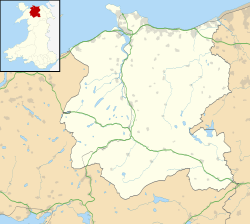Canovium facts for kids
Quick facts for kids Canovium |
|
|---|---|

View from the fort down to the River Conwy
|
|
| Founded | c. 75 AD |
| Abandoned | 4th century AD |
| Place in the Roman world | |
| Province | Britannia |
| Structure | |
| — Stone structure — | |
| Built | 2nd century AD |
| — Wood and earth structure — | |
| Location | |
| Coordinates | 53°12′58″N 3°50′03″W / 53.2161°N 3.8341°W |
| County | Conwy |
| Country | Wales |
| Reference | |
| UK-OSNG reference | SH775702 |
Canovium was a Roman fort located in the ancient Roman province of Britannia. Today, you can find its site at Caerhun in the Conwy valley in North Wales. It is part of the county borough of Conwy.
Contents
Building a Roman Fort
Canovium was first built around the year AD 75. The Roman army chose this spot because it was an important place to cross the River Conwy, near a spot called Tal-y-Cafn.
The first fort was made of timber (wood) and earth. It was shaped like a square. It was probably home to about 500 foot-soldiers. These soldiers helped the Romans control the area.
From Wood to Stone
In the early 2nd century, the Romans started to rebuild the fort. They used strong stone instead of wood. This made the fort much more durable.
Inside the fort, there were several important buildings:
- A headquarters building, where the fort's leaders worked.
- A large house for the commanding officer.
- Granaries, which were special buildings for storing grain and food.
- Barrack blocks, where the soldiers lived.
It's interesting that the headquarters and the commanding officer's house were very large. They were bigger than usual for a fort of this size.
Outside the main fort, there was a bath-house to the east. This was a place for soldiers to wash and relax. To the north, there was a large vicus. A vicus was like a small town or village. It grew up around the fort, where civilians lived and traded with the soldiers.
A Special Milestone
About 7 miles from Canovium, a large stone was found. This stone is called a milestone. It was dedicated to the Emperor Hadrian, who ruled the Roman Empire. This milestone is now kept in the British Museum.
Later Years of the Fort
The fort might have been empty for a short time in the late 2nd century. But the Romans quickly came back and started using it again. They even built a new cookhouse.
Canovium continued to be used by the Romans until at least the late 4th century. This means it was active for over 300 years!
Today, part of the fort's old site is used by a church. The parish church of St Mary was built there in the 14th century. Its churchyard also covers some of the ancient fort.
Studying Canovium
Many people have studied the Canovium fort over the years. You can find more information about these studies through the Kanovium Project.
One important study was done in 1938 by P.K. Baillie Reynolds. He was a researcher from Aberystwyth University. He spent four summers digging at the site. His work helped us learn a lot about what Canovium was like.
See also
 In Spanish: Canovium para niños
In Spanish: Canovium para niños


